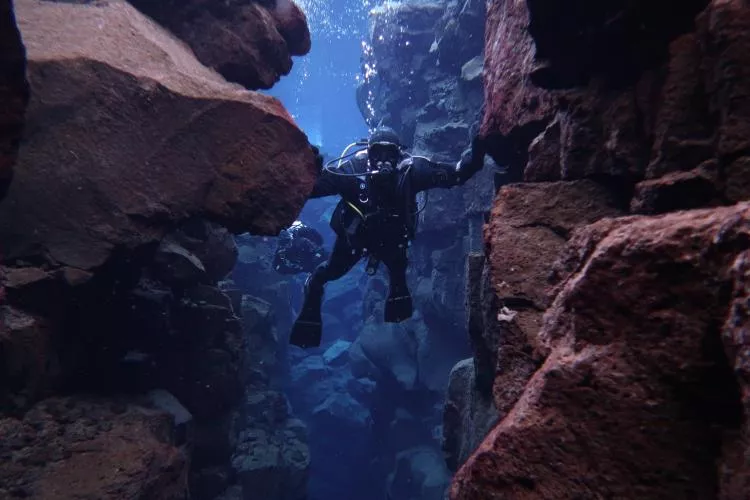Human factors is about making it easier to do the right thing and harder to do the wrong thing. Therefore, for divemasters, human factors is about making it easier for them and their divers to do the right thing and harder to do the wrong thing.
Contributed by
Human factors is usually considered a way to make diving safer, but it actually goes far beyond that and can be used to great benefit to maximise individual and team performance and get much more out of diving.
The world of human factors is huge, so this article will focus on a few subjects that come under the human factors umbrella. Besides offering some specific guidance, it will hopefully provoke some thought into how you might apply the concepts to your own divemastering style.
Is there a problem?
Most of the diving involving divemasters is relatively shallow and recreational in nature, but it comes with its own set of challenges. Bad things do happen to divers while under the supervision of divemasters, which we obviously want to avoid.
Almost all accidents and incidents happen as a result of several small things coming together, resulting in something bigger going wrong. In isolation, the small things do not usually matter until a big thing happens, and we look back with hindsight and see the small things clearly. The main problem therefore are all these small things that have the potential to add up to become a big thing.
It is very difficult, if not impossible, to change human behaviour, as we have been this way for millennia. What we can do more easily is change the conditions associated with a situation or environment that encourage or promote human error rather than change the errors themselves.
Not quite a “drift” dive
Here is a real-life story, which is a great way of getting the concept across:
A group of divers surfaced from a dive and found themselves farther away from their boat than they expected due to more current than anticipated. Attempts to signal the boat were unsuccessful, and they eventually drifted out of sight. Some two to three hours later, they luckily came across an oil platform and were subsequently picked up by the dive centre’s boat.
This incident, like many others, had numerous small problems that almost came together to result in something very serious. Let’s consider three aspects from this story and what we could do about them.
- More current than expected
- Boat crew not keeping sufficient lookout
- Divers being hard to see
So, how do human factors fit into all this? Here are three things to consider:
Devices & lookouts. Identify the conditions present that make an unfavourable outcome more likely. Make it easier to do the right thing. In this case, ensuring that divemasters have a surface marker buoy (SMB) from the start or sending up a delayed surface marker buoy (DSMB) early, once the current is noticed, will allow the boat to track the divers better from the surface.
Make sure that lookouts on the boat have a good, preferably elevated vantage point and are especially active once the intended dive time has expired. (An accurate dive log is very helpful here.) Take bigger and/or better signalling devices. DSMBs come in many shapes and sizes, but whistles or flares/emergency beacons can be useful too.
Debrief. The main thing that you can do is have a debriefing when things do not go according to plan. An effective debrief requires good communication skills to ensure that lessons are learnt, and all the relevant information is disseminated and understood by everyone involved. A debrief must not be about identifying who is to blame. A debrief needs to be about identifying what caused the problem.
Leadership. Divemasters are leaders. Effective leadership comes in many forms, and for the divemaster, the dive brief is the perfect time to set the tone and demonstrate that you are the divemaster you, yourself, would want to follow. When giving the dive brief, let your divers know what to probably expect but also what to possibly expect. This will all help the team if and when things do not go exactly to plan.
Specific techniques
Here are some specific things a divemaster can do before, during and after a dive. While primarily they are there to help make the dive safer, they will also help the whole team get more out of the dive and learn for future dives.
Before the dive
Personal introductions. This is all part of the foundation of psychological safety, which has to do with creating an environment where people in a team feel safe to speak up about things that they are not comfortable with. Greet people with a smile, maintain eye contact, start a conversation. Tell them your name and that you will be their divemaster. Make sure you ask for their names and try to remember them. Encourage them to come to you with any questions and concerns they may have.
Check gear. Check people’s gear because you want to know how it works. How do you get rid of their weights? How do you inflate their BCD or wing? It is important that you tell them why you are doing this, so they do not think you are just double-checking their setups. They need to know you are doing it for everyone’s benefit.
Tailorise briefings. Engage your audience during the brief and tailor it to them. If everyone has done the site before, there is no point in describing the site in detail. Check the understanding of hand signals. Find out what responses you will get if you tap your fingers into your palm (asking for gas amount). Different countries use psi and bar; different agencies teach different signals to show gas amount. It is far easier to figure this out on the surface beforehand.
Use a checklist. I encourage briefing from a checklist to minimise the chances of missing something. It is easy to get distracted during a brief and then forget what you were saying. A checklist can help remind you.
Set the example. Be the divemaster you would want to follow. Do your pre-dive checks with a buddy and make sure people see you doing them.
During the dive
Closed-loop communications. This has to do with repeating a message back to someone to check it has been understood correctly. As well as confirming understanding, it also cements the message better in your brain’s memory banks by engaging more parts of the brain.
For example, when someone gives a hand signal for gas amount, repeat it back to them and say it to yourself through your regulator. That confirms to them that you have understood it correctly and gives you a better chance of remembering it after you have asked another five or six people.
When you give a signal, ask your divers to not just respond to you with the “OK” signal but to repeat the original signal back. When giving a “thumbs-up” at the end of the dive, you want to know that others know you are on ascent, and the best way for you to know they understand this is for them to reply with the same “thumbs-up” signal.
Exaggerate correct technique. When you enter the water, use and even exaggerate the correct technique. For a giant stride, make it clear you are looking at the horizon and taking a big step out. When you are exiting the water, keep your regulator in and mask on until back in the boat. There are many stories out there of people doing poor giant strides and then their tanks hit the boat, causing it to hit the back of their head. There are also many stories out there of people being overcome by waves and spray on the surface, which would not have happened had they kept a regulator in their mouth. As the divemaster, set a good example—people are likely to follow your lead.
Take notes. If you see something you are not happy with, you can make a note to discuss it afterwards. For example, if someone has poor trim and their fins are constantly in the coral, you can talk to them about ways to improve and give them reasons why.
If you see a variety of interesting wildlife, notes will help people with their logbooks and can also help you if someone else points something out that you cannot identify at the time. I was at a local site a couple of months ago and my buddy pointed out what I thought was a frogfish. I made a note, which prompted me to ask him about it afterwards, and he confirmed it was a frogfish and that they are often found in that spot. This helps me offer a better service to other customers in the future.
After the dive
Have a debrief. It does not need to be a long, drawn-out affair. If the dive was uneventful, it can be enough to make sure everyone is feeling well and had a good time. Ask for any feedback and be grateful when it is offered. From the notes you have taken, ask others if they would like feedback. If they say “yes,” offer them advice on how to improve.
To help with this, it is important to make feedback about observable behaviour rather than the individual. For example, rather than saying, “Dave, your fins were constantly in the coral. You did so much damage. You need to do it better,” say something like, “Dave, a horizontal swimming position is much better to avoid damaging the coral and is a much more efficient way to swim.” The latter phrase is about Dave’s technique or behaviour rather than specifically about Dave and is naturally more palatable, even though you are explaining the same concept.
Talk about mistakes. If you have done something wrong or made a mistake, talk about it. This demonstrates humility and encourages others to speak up. Recently, when leading a big group, it took me longer than I expected to get back to the anchor line, which led to us surfacing a few minutes over time and my buddy had slightly less than 50bar, which violated the standards I had set at the start. Afterwards, I discussed it with my buddy, reflected on it, and learnt that in future, with a big group at that site, I need to allow more time to get back to the anchor line.
Reply to feedback. If you do receive feedback, act on it and, if possible, show that you have acted on it. For example, if someone comments that your brief did not cover something, change your brief accordingly, especially if that someone is a regular customer and will hear your brief again!
If you receive feedback via email, take two minutes to reply. Too often, feedback disappears into the ether, and those who spent time giving it have no idea what happened to it so are less likely to give feedback in the future. I have sent a couple of emails to dive companies offering feedback after the trip and never had a reply, which I found quite disappointing.
Summary
Human factors is about making it easier to do the right thing. Whether you are planning, briefing, actually doing a dive, or reflecting on a dive you have done, look at the conditions present not just the errors themselves. Was there enough time for a thorough briefing and pre-dive checks? Was effort made to engage with the novice divers in the group to make sure they were completely comfortable? If you have a real-life rescue situation but you have not done any rescue training as a team before, then do not be surprised if it does not go very well.
Set the example. Do your best with demonstrating technical skills, with briefings and with pre-dive checks. Engage with people—smile, maintain eye contact, be enthusiastic, but be humble and admit your mistakes. Enjoy what you are doing and show people that you are enjoying it.
Be the divemaster that you would want to follow.
Michael Mason is an experienced military pilot and flying instructor in his day job and works as a divemaster on weekends. He is also training to become an instructor for The Human Diver and is always striving to improve diving by applying human factors.





























